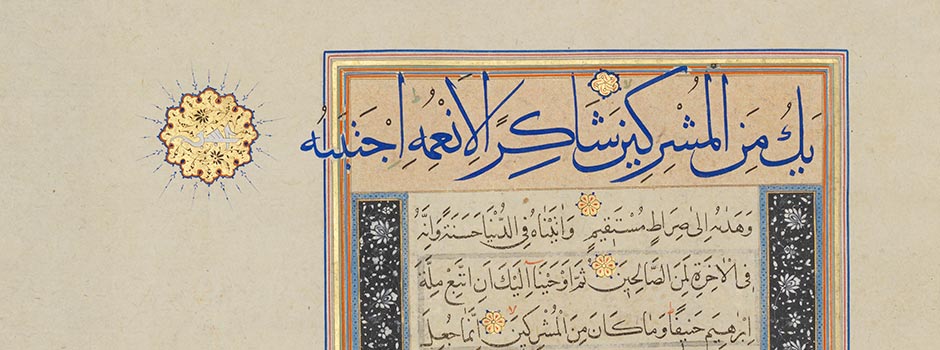
MANUSCRIPT EXHIBITION (14 April – 28 August 2016) Lapis and Gold, The Story of the Ruzbihan Qur’an
Jul 26, 2016 Manuscripts

The exhibition, which was officially opened by the President of Ireland, Michael D Higgins,on 14 April, runs until 28 August 2016. It is free to visitors and is supported by a programme of lectures and workshops.
The manuscript’s renown has traditionally rested with the name of its calligrapher, but it is equally the quality, extent and complexity of its decoration - the work of highly skilled artists and craftsmen - that sets it apart. The Ruzbihan Qur’an opens with an apparent burst of light in the form of paired shamsas. Each shamsa (‘sun’) is executed mainly in lapis and gold—the two most expensive pigments available to the illuminator—and surrounded by near-shimmering rays.
 Ruzbihan Qur’an / Courtesy of Chester Beatty Library
Ruzbihan Qur’an / Courtesy of Chester Beatty Library
 Ruzbihan Qur’an / Courtesy of Chester Beatty Library
Ruzbihan Qur’an / Courtesy of Chester Beatty Library
A major conservation project has revealed new information about the materials and techniques used in producing the manuscript - a technical and artistic triumph of its time. The results of the analysis will be published in book form later this year.
Fionnuala Croke, Director of the Library said: "Chester Beatty’s Islamic collection is regarded as one of the finest in the world and the Ruzbihan Qur’an is extraordinarily beautiful. Part of our mission at Chester Beatty is to increase understanding of the cultures that are represented in our collections. Through our displays and public programme, we help our visitors to understand the present through the past, as well as the interconnections between cultures."
 Ruzbihan Qur’an / Courtesy of Chester Beatty Library
Ruzbihan Qur’an / Courtesy of Chester Beatty Library
The exhibition showcases thirty-two single folios and double-page openings, with another twenty-one folios partially displayed to facilitate discussion of the pigments used. Three other 16th-century Qur’ans from the Library’s collection are also on display. Extensive work was done on the Qur’an in the Chester Beatty Library conservation laboratory where a dedicated team specialise in the treatment of books and manuscripts.
This manuscript consists of some 445 folios, most of which have an area of text framed by narrow bands of pigment. Over the centuries, a copper-containing green pigment known as atacamite had burned through the paper causing some text areas to split along the line of green. This situation was exacerbated by the restrictive nature of the manuscript’s later nineteenth century binding. The decision was made to disbind the manuscript in 2012 to allow for extensive conservation work. Conservation techniques were researched and adapted to ensure the preservation of the manuscript and treatments included the repair of spine-folds, painstaking stabilisation of each split frame and consolidation of flaking pigments under magnification.
 Ruzbihan Qur’an / Courtesy of Chester Beatty Library
Ruzbihan Qur’an / Courtesy of Chester Beatty Library
Conservation provided a unique opportunity for the close technical examination of this Qur’an. The European-funded MOLAB programme sponsored a team of scientists from Italy and France to travel to Dublin to work with conservation and curatorial staff to carry out non-invasive pigment analysis. Scientific research can help to provide insights into the date and provenance of items, and the development of practical conservation techniques. This analysis identified the pigments being used in Shiraz in the sixteenth century and more importantly the corrosive green pigment which had deteriorated causing damage to the manuscript.
The curator of the exhibition Dr. Elaine Wright, is also curator of the Islamic Collections at Chester Beatty. Dr. Wright is the author of several books and has extensive experience in the field of manuscript studies.
Comments
Add a comment